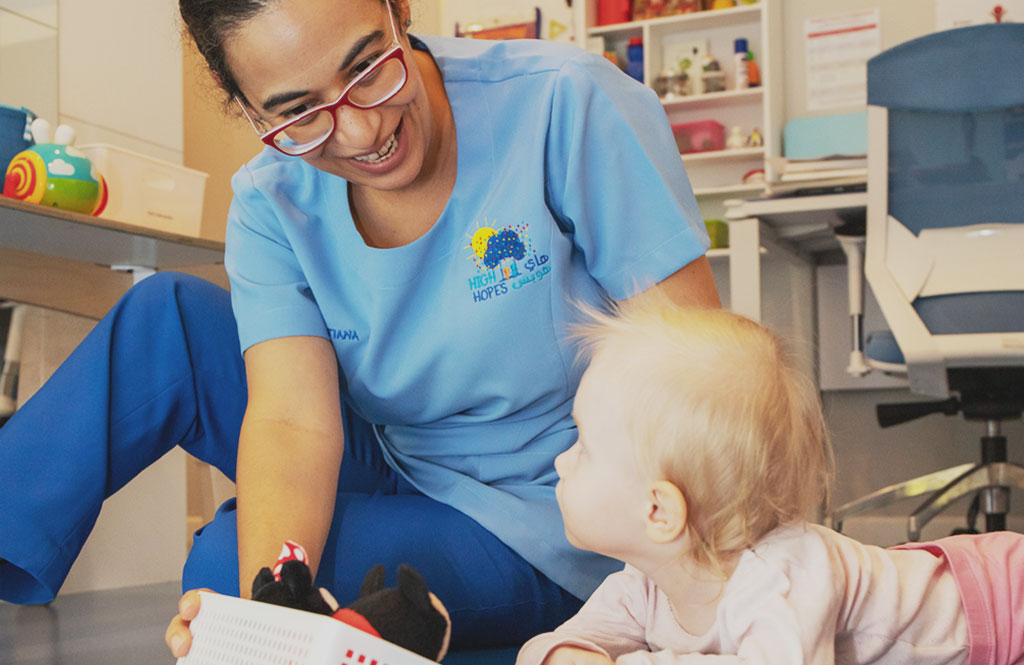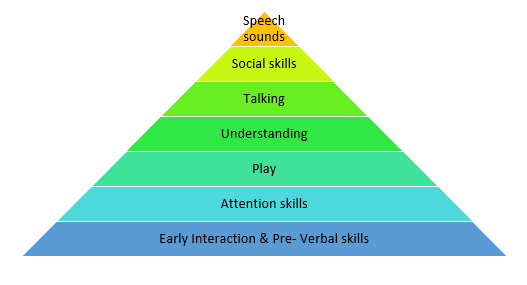
In our early intervention clinic, we frequently meet with families preoccupied with their infant’s lack of words, or limited vocabulary. Our speech and language therapists commonly encounter parents who, in the initial consultation, report that “our child is not talking yet, while all other children in the nursery can talk in full sentences already.” The initial consultation is an opportune moment to explore the child’s general development and its impacts on speech development.
Therapists typically ask parents a myriad of questions on their child’s development to identify any other associated delays that might be causing or contributing to the speech delay. For example, if the child displays a motor delay, it is very likely that other skills will also present a delay. If the child has experienced a temporary hearing loss because of recurring ear infections, it is likely that they will present difficulties with speech since they were deprived of auditory input for an extensive period.
In my speech and language therapy practice, I encourage parents to focus on communication rather than speech. While speech is our primary means of communication, communication comprises more than speech, as it includes facial expressions, gestures, and body language. This is why we have sayings like “if you tie up an Italian’s hands, they won’t be able to talk.” In normal development, communication is not limited to speech. A child typically conveys their first message much earlier than their first word through gestures, such as waving goodbye or raising their arms to ask to be lifted.
For a child to communicate through either gestures or speech, they require a set of prerequisite skills, the pre-verbal skills. The picture below displays the communication skills development pyramid, with the pre-verbal skills included in the bottom while speech development is at the top.

The pyramid explains why speech and language therapists work on various skills before addressing speech, and why they emphasize building rapport and developing a connection with the child.
Deficits in the following children’s preverbal skills are often identified in early intervention:
- Mutual gaze
- Attention
- Imitation
- Turn-taking
Each skill plays a vital role in communication development and can be promoted as follows:
- Mutual gaze: communication between two people involves looking at each other, in addition to talking. Establishing and maintaining eye contact is hence an important skill that can help communicate feelings and emotions. Mutual gaze can be improved with such activities as:
-
- Tracking: try blowing balloons and bubbles with your child slowly, wait for your eyes to meet before blowing more bubbles.
- Peek-a-boo games: can be played behind furniture, behind towels when drying off after shower, or when getting dressed.
- Attention: children usually have a short attentional span. By working on attention skills, we aim to extend the time a child is able to focus on one activity. Try to eliminate distractions, choose toys your child is interested in, and add a surprise element to games, like putting toys in a box. Try to follow your child’s lead, sometimes just sitting next to them and making comments about what they are doing makes a significant impact. Attention can be improved with activities including:
-
- Balloons: blow them up and let them go, make appropriate noises like “wheeeee, whoooosh!” Throw and catch the balloons, draw faces on them, and if your child is not auditory-defensive, try popping them.
- Stacking cups: build different towers/sandcastles with them, roll them over, wash them, hide them around the room, hide things inside them and play memory games, hide your child’s favorite snack in one of them.
- Imitation: this skill involves cooperation and interaction between people, which is necessary for communication. Also, it helps with motor planning, with speech being a motor skill. Join your child when playing and try to copy what they are doing, encourage them to copy you too. Early imitation can be enhanced with multiple activities including:
-
- Routine: children love copying daily routines. Try to leave a small brush so your child can imitate brushing their hair or that of their teddy bear.
- Blocks: start following your child’s lead. For example, if they bang two blocks together, you do the same. Then try to extend the play and see if your child can copy building a tower, etc.
- Early pretend play: first copy your child’s actions—if they put a slipper on, you do the same. Later see if your child will imitate other actions, like putting a spoon in their mouth, or sipping from a cup. Try to add onomatopoeic sounds to these actions to further engage your child.
- Turn-taking: good communication skills include listening, waiting, and taking turns to respond—we cannot communicate if everybody talks at the same time. Turn-taking can be improved at an early age. At the outset, try to work on this skill exclusively with your child and then try to involve siblings or other children. The more people get involved, the longer the wait is, which can be frustrating for children experiencing language delay. Start turn-taking with toys or physical activities, then move on to speech or songs. Your child will learn quickly that sharing and taking turns is great fun through these activities:
-
- Ball games: take turns rolling the ball, kicking for each other.
- Cars: take turns pushing a car towards each other.
- Balloons: take turns throwing a balloon up into the air while you make funny comments and sounds, giving more opportunity for your child to play.
- Stacking cups: take turns building a tower before knocking it down.
- Shape sorter: take turns putting shapes in and taking them out of the sorter.
These are some tips to nurture your child’s pre-verbal skills. It is important to make activities fun and to follow your child’s lead. During play, you can further involve your child by making comments about what you are doing instead of simply asking them questions. Let me know if you have any questions or comments.





